Worldwide, there are over 6,000 jumping spider species. In North America and Hawaii, 357 jumping spider species can be found (as of 2021). This article provides an overview of all these jumping spider species by genera that can be found in America north of Mexico.
Jumping spiders are a family of spiders with the ability to jump. Their scientific name is Salticidae. Jumping spiders don’t use muscles in their legs to jump. Instead, they suddenly increase the blood flow to their rear legs. This sudden increase propels the spiders forward. A juvenile Hypaeus jumping spider was observed jumping over 10 inches (25 cm) on a horizontal surface. That was more than 45 times its body length.
In 2015, the taxonomy in the family Salticidae was significantly simplified. Today, the family consists of seven subfamilies. In the United States and Canada, only two of the seven jumping spider subfamilies occur: Lyssomaninae and Salticinae. Worldwide, over 90% of all jumping spider species belong to the subfamily Salticinae.
Table of Contents
Lyssomaninae
Lyssomanes
Jumping spiders of the genus Lyssomanes can be found throughout the warm regions of the Americas. In the United States, only one species, Lyssomanes viridis, the magnolia green jumper, can be found. Lyssomanes are often green or yellow long-legged spiders with translucent bodies.
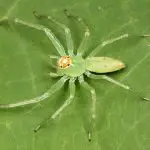
Lyssomanes Viridis – Magnolia Green Jumper
Salticinae
The subfamily Salticinae is the largest jumping spider subfamily with over 90% of all jumpers. Apart from the magnolia green jumper, all jumping spiders found in the United States are part of the Salticinae subfamily. The subfamily itself is divided into two clades (Amycoida and Salticoida).
Clade Amycoida
Attinella
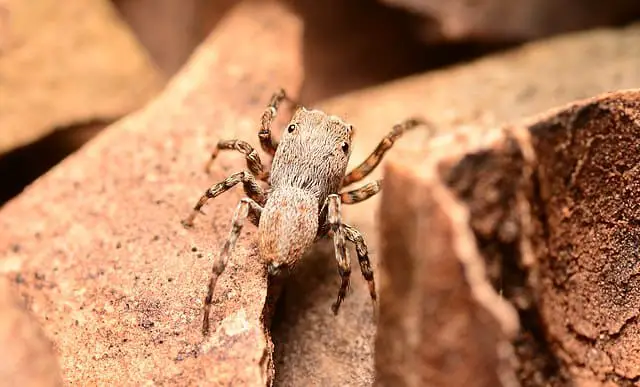
- Attinella concolor (Banks, 1895)
- Attinella dorsata (Banks, 1895)
- Attinella juniperi (Gertsch & Riechert, 1976)
Attulus
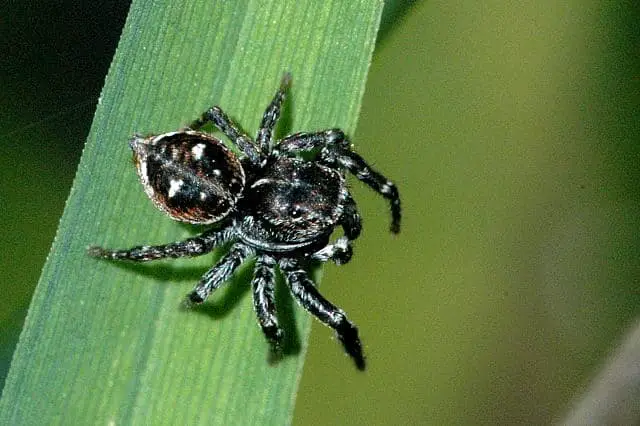
- Attulus finschi (L. Koch, 1879)
- Attulus floricola (C. L. Koch, 1837)
- Attulus pubescens (Fabricius, 1775)
- Attulus striatus (Emerton, 1911)
- Attulus sylvestris (Emerton, 1891)
Colonus
Colonus is a genus of jumping spiders found throughout the Americas. All species have spines on the inner sides of their legs. The function of these is still unknown.
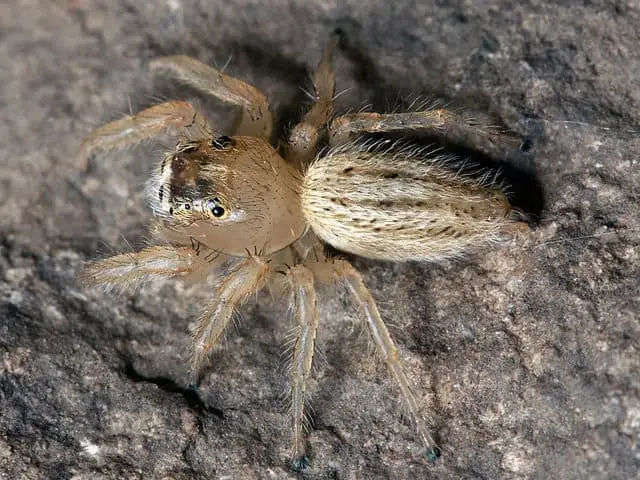
- Colonus hesperus (Richman & Vetter, 2004)
- Colonus sylvanus (Hentz, 1846)
- Colonus puerperus (Hentz, 1846)
Hyetussa
- Hyetussa alternata Gertsch, 1936
- Hyetussa complicata Gertsch, 1936
Sarinda
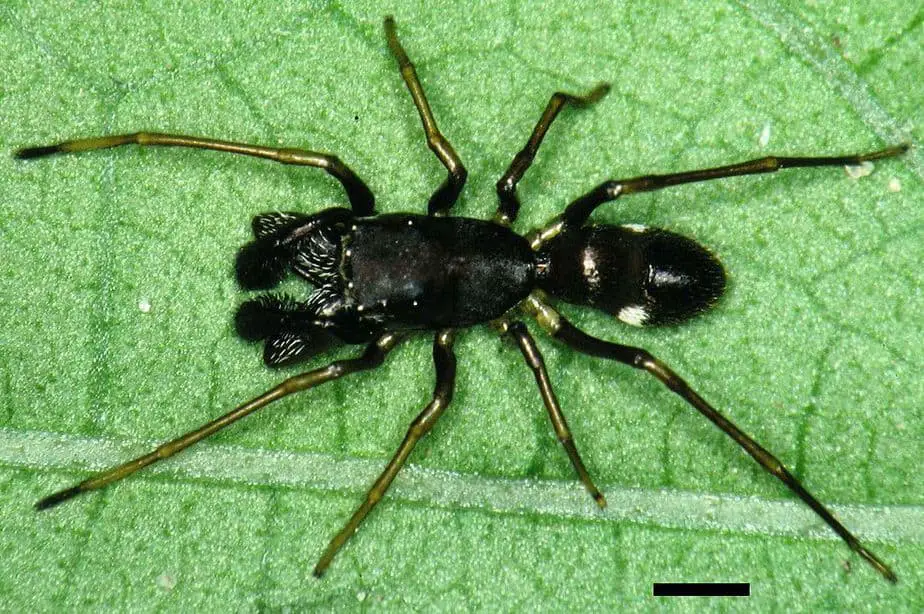
- Sarinda hentzi (Banks, 1913)
Sittisax
- Sittisax ranieri (Peckham & Peckham, 1909)
Synemosyna
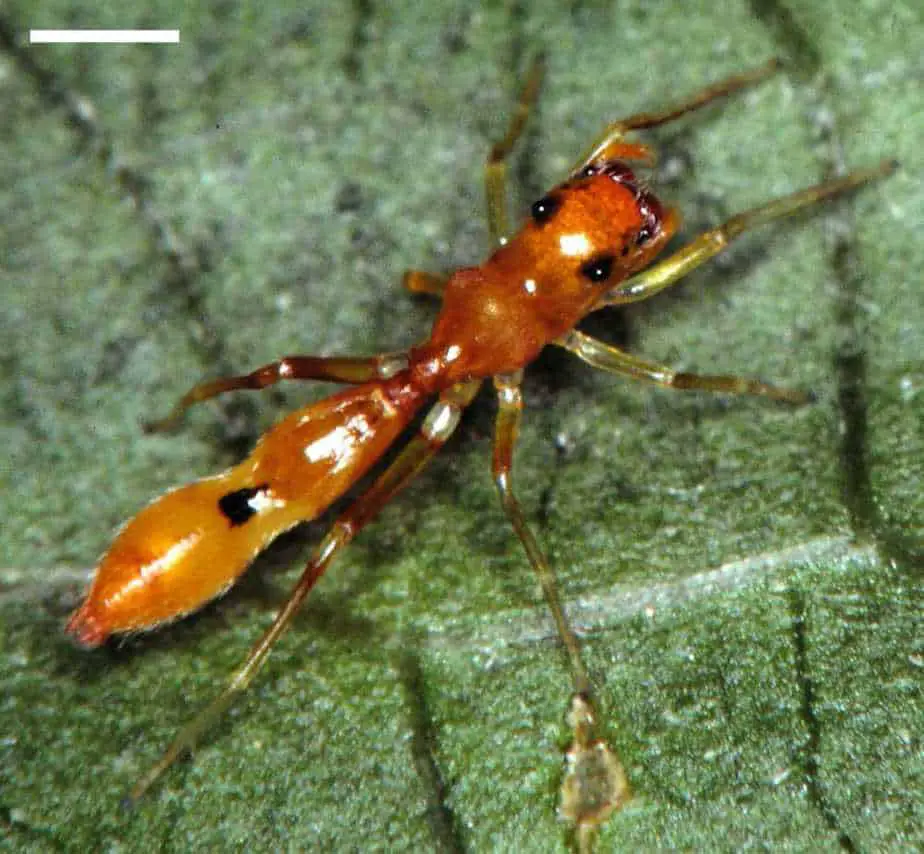
Synemosyna are a genus of ant mimicking jumping spiders found throughout the Americas. Two species are found in the United States:
- Synemosyna formica Hentz, 1846
- Synemosyna petrunkevitchi (Chapin, 1922)
Tomis
- Tomis welchi (Gertsch & Mulaik, 1936) (syn. Sitticus welchi)
Clade Salticoida
Admestina
Admestina is a genus of jumping spiders that is endmeic to North America. The spiders are mostly found in forests and have a flat cephalothorax which is believed to help them hide in crevasses. The three species of the genus are all found in the United States:
- Admestina archboldi Piel, 1992
- Admestina tibialis (C. L. Koch, 1846)
- Admestina wheeleri Peckham & Peckham, 1888
Anasaitis
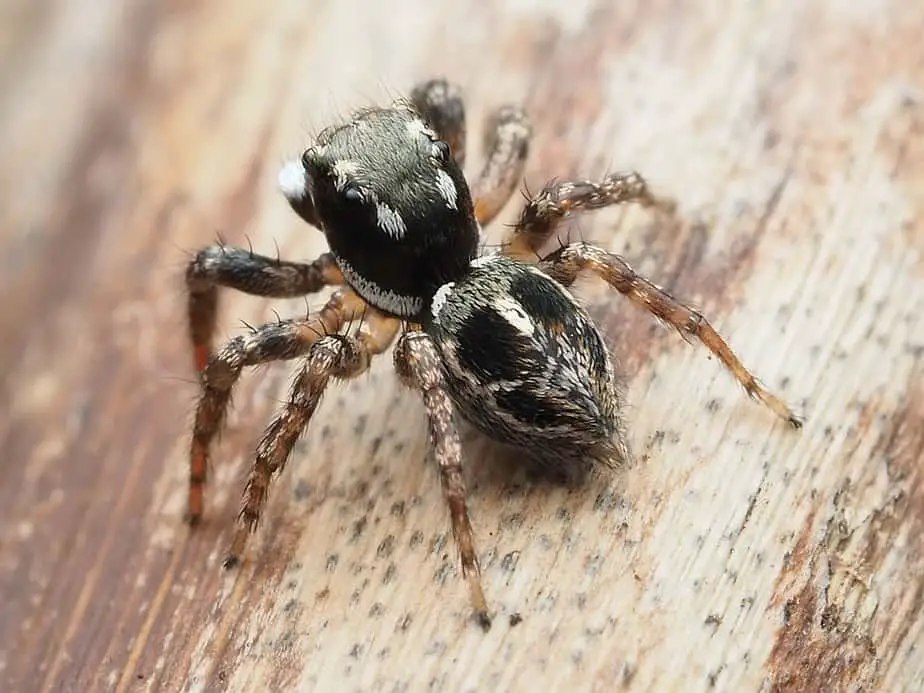
- Anasaitis canosa (Walckenaer, 1837)
Attidops
- Attidops cinctipes (Banks, 1900)
- Attidops cutleri Edwards, 1999
- Attidops nickersoni Edwards, 1999
- Attidops youngi (Peckham & Peckham, 1888)
Bagheera
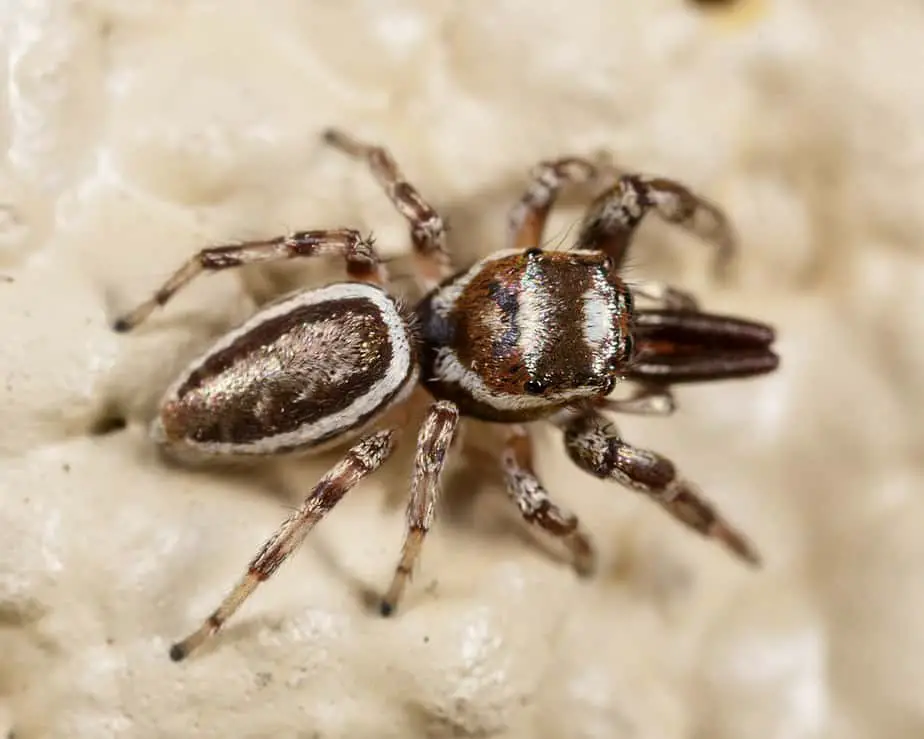
- Bagheera prosper (Peckham & Peckham, 1901)
Beata
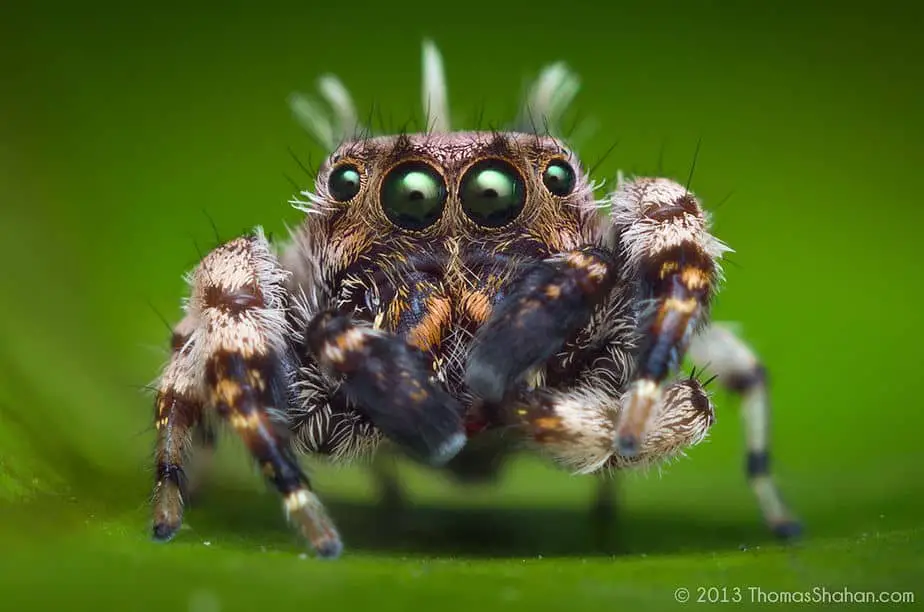
The genus Beata contains 21 jumping spider species found throughout America. Only one of the species is found in the United States:
- Beata wickhami (Peckham & Peckham, 1894)
Bellota
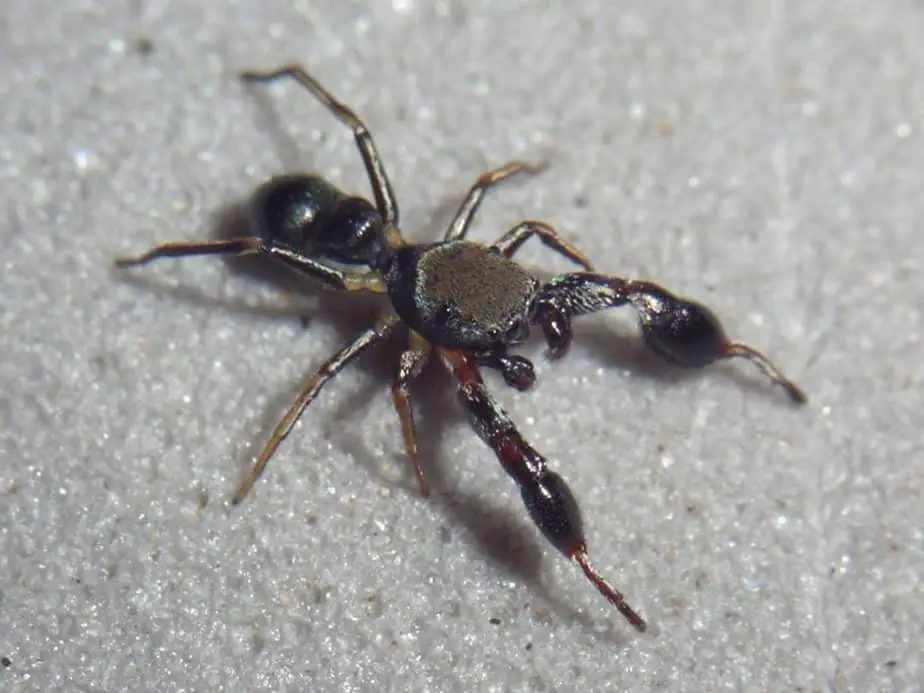
- Bellota micans Peckham & Peckham, 1909
- Bellota wheeleri Peckham & Peckham, 1909
Chalcoscirtus
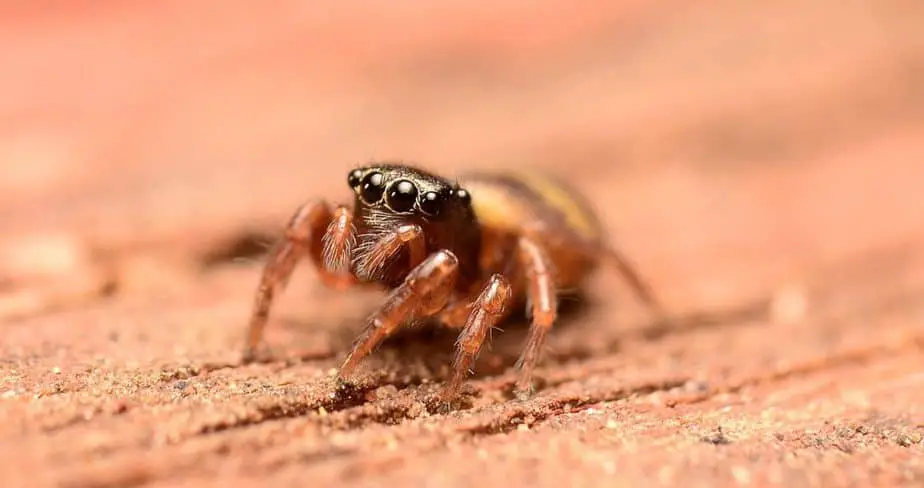
- Chalcoscirtus carbonarius Emerton, 1917
- Chalcoscirtus diminutus (Banks, 1896)
- Chalcoscirtus glacialis Caporiacco, 1935 – (Alaska)
Cheliferoides
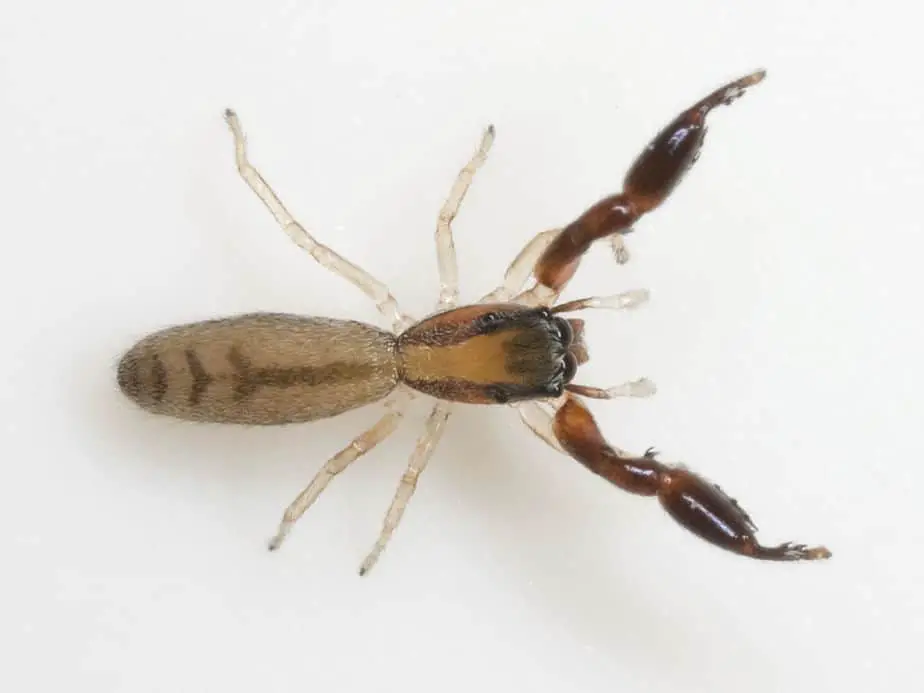
Cheliferoides are jumping spiders with a strong and thick leg of front pairs resembling a scorpion. There are three species in this genus that can all be found in the United States.
- C. longimanus Pickard-Cambridge, 1901
- C. planus Pickard-Cambridge, 1901
- C. segmentatus Pickard-Cambridge, 1901
Chinattus
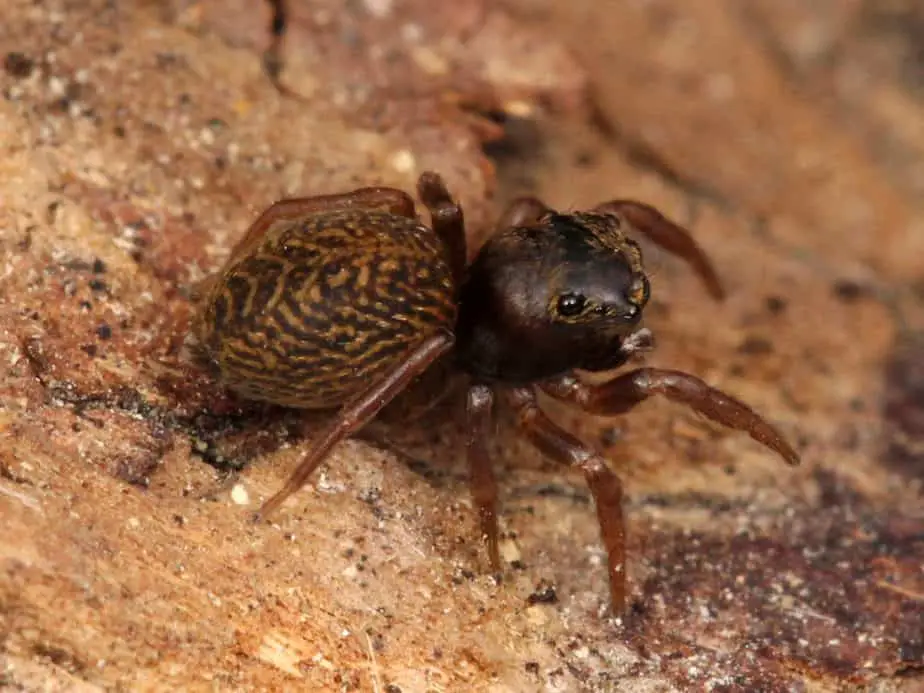
- Chinattus parvulus (Banks, 1895)
Corythalia
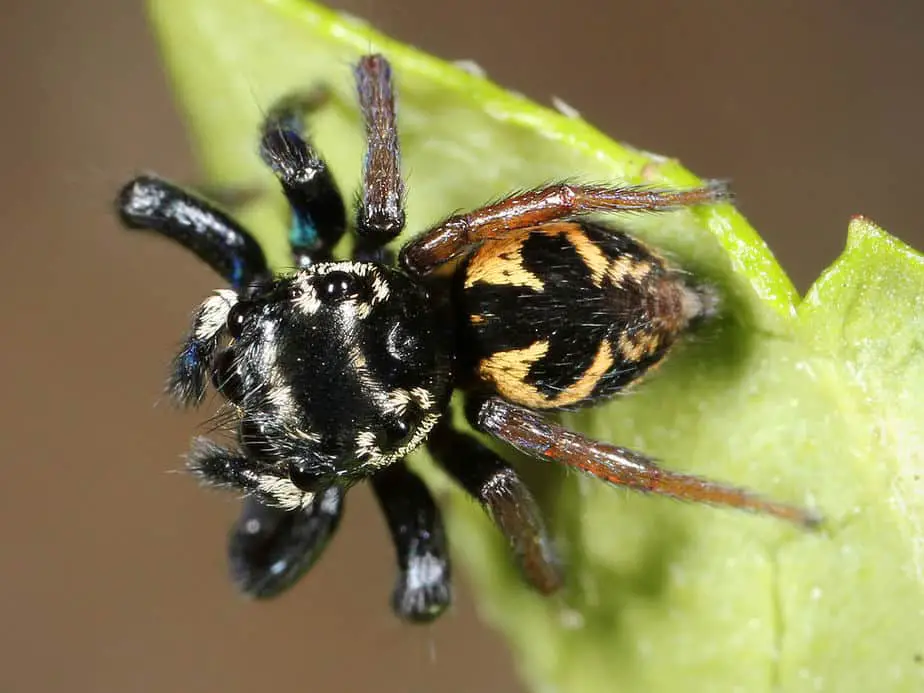
The genus Corythalia is a genus of jumping spiders found throughout the Americas. Of the 29 species in the genus, 2 are found in North America:
- C. conspecta (Peckham & Peckham, 1896)
- C. opima (Peckham & Peckham, 1885)
Dendryphantes
Spiders of the genus Dendryphantes can be found throughout the world. Only one of the 69 species occurs in North America:
- Dendryphantes nigromaculatus (Keyserling, 1885)
Epocilla (only in Hawaii)
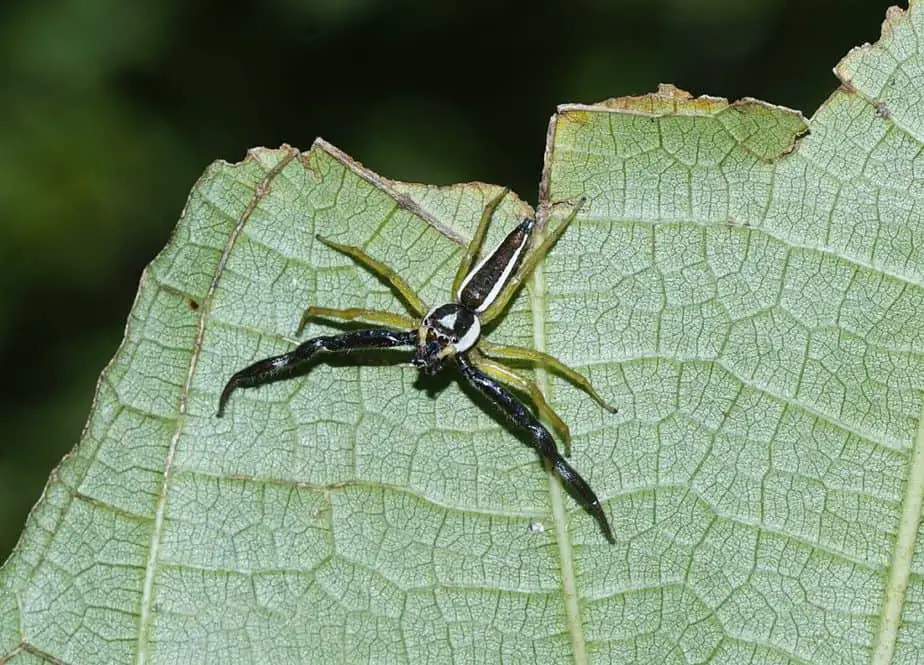
- Epocilla calcarata (Karsch, 1880) – Introduced to Hawaii from Asia
Evarcha
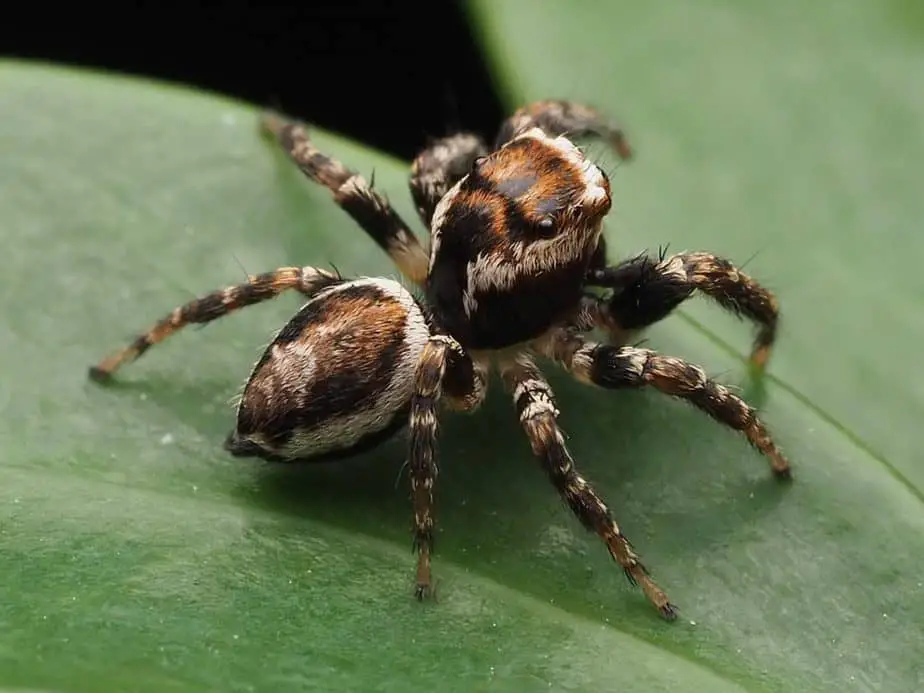
- Evarcha amabilis (C. L. Koch, 1846)
- Evarcha proszynskii Marusik & Logunov, 1998
- Evarcha hoyi (Peckham & Peckham, 1883)
Eyuophrys
- E. monadnock Emerton, 1891
Eris
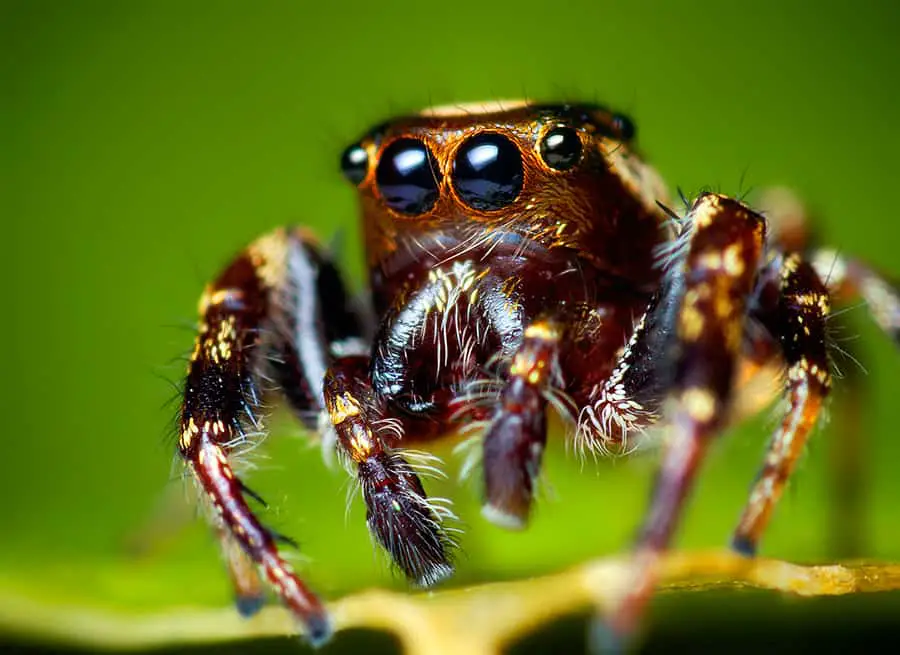
- Eris flava (Peckham & Peckham, 1888)
- Eris floridana (Banks, 1904)
- Eris limbata
- Eris militaris (Hentz, 1845)
- Eris rufa (C. L. Koch, 1846)
Ghelna
- Ghelna barrowsi (Kaston, 1973)
- Ghelna canadensis (Banks, 1897)
- Ghelna castanea (Hentz, 1846)
- Ghelna sexmaculata (Banks, 1895)
Habronnatus
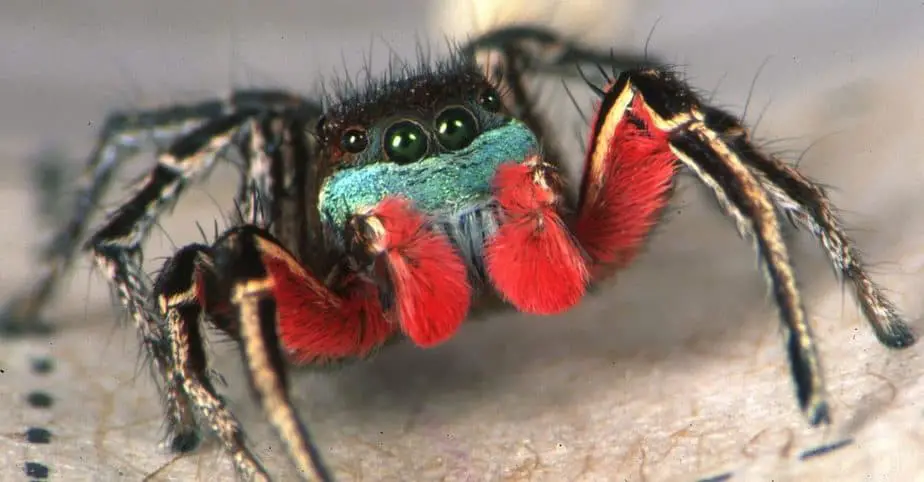
Habronatus is a genus of jumping spiders found throughout the Americas with 106 recognized species. 72 of the species are found in the United States and/or Canada. Spiders of the genus Habronatus are commonly referred to as paradise spiders due to their colorful ornaments and mating dances that resembles the appearance and behavior of birds of paradise.
- Habronattus agilis (Banks, 1893)
- Habronattus alachua Griswold, 1987
- Habronattus altanus (Gertsch, 1934)
- Habronattus americanus (Keyserling, 1885)
- Habronattus amicus (Peckham & Peckham, 1909)
- Habronattus anepsius (Chamberlin, 1924)
- Habronattus arcalorus Maddison & Maddison, 2016
- Habronattus ballatoris Griswold, 1987
- Habronattus borealis (Banks, 1895)
- Habronattus brunneus (Peckham & Peckham, 1901)
- Habronattus bulbipes (Chamberlin & Ivie, 1941)
- Habronattus calcaratus (Banks, 1904)
- Habronattus californicus (Banks, 1904)
- Habronattus captiosus (Gertsch, 1934)
- Habronattus carolinensis (Peckham & Peckham, 1901)
- Habronattus clypeatus (Banks, 1895)
- Habronattus cockerelli (Banks, 1901)
- Habronattus coecatus (Hentz, 1846)
- Habronattus cognatus (Peckham & Peckham, 1901)
- Habronattus conjunctus (Banks, 1898)
- Habronattus cuspidatus Griswold, 1987
- Habronattus decorus (Blackwall, 1846)
- Habronattus delectus (Peckham & Peckham, 1909)
- Habronattus dorotheae (Gertsch & Mulaik, 1936)
- Habronattus elegans (Peckham & Peckham, 1901)
- Habronattus fallax (Peckham & Peckham, 1909)
- Habronattus festus (Peckham & Peckham, 1901)
- Habronattus formosus (Banks, 1906)
- Habronattus forticulus (Gertsch & Mulaik, 1936)
- Habronattus georgiensis (Chamberlin & Ivie, 1944)
- Habronattus geronimoi Griswold, 1987
- Habronattus gilaensis Maddison & Maddison, 2016
- Habronattus hallani (Richman, 1973)
- Habronattus hirsutus (Peckham & Peckham, 1888)
- Habronattus icenoglei (Griswold, 1979)
- Habronattus jucundus (Peckham & Peckham, 1909)
- Habronattus kawini (Griswold, 1979)
- Habronattus klauseri (Peckham & Peckham, 1901)
- Habronattus kubai (Griswold, 1979)
- Habronattus leuceres (Chamberlin, 1925)
- Habronattus luminosus Maddison, 2017
- Habronattus mataxus Griswold, 1987
- Habronattus mexicanus (Peckham & Peckham, 1896)
- Habronattus moratus (Gertsch & Mulaik, 1936)
- Habronattus mustaciatus (Chamberlin & Ivie, 1941)
- Habronattus nemoralis (Peckham & Peckham, 1901)
- Habronattus neomexicanus (Chamberlin, 1925)
- Habronattus notialis Griswold, 1987
- Habronattus ocala Griswold, 1987
- Habronattus ophrys Griswold, 1987
- Habronattus orbus Griswold, 1987
- Habronattus oregonensis (Peckham & Peckham, 1888)
- Habronattus peckhami (Banks, 1921)
- Habronattus pugillis Griswold, 1987
- Habronattus pyrrithrix (Chamberlin, 1924)
- Habronattus sabulosus (Peckham & Peckham, 1901)
- Habronattus sansoni (Emerton, 1915)
- Habronattus schlingeri (Griswold, 1979)
- Habronattus signatus (Banks, 1900)
- Habronattus sugillatus Griswold, 1987
- Habronattus superciliosus (Peckham & Peckham, 1901)
- Habronattus tarsalis (Banks, 1904)
- Habronattus texanus (Chamberlin, 1924)
- Habronattus tranquillus (Peckham & Peckham, 1901)
- Habronattus trimaculatus Bryant, 1945
- Habronattus tuberculatus (Gertsch & Mulaik, 1936)
- Habronattus ustulatus (Griswold, 1979)
- Habronattus venatoris Griswold, 1987
- Habronattus virgulatus Griswold, 1987
- Habronattus viridipes (Hentz, 1846)
Hakka
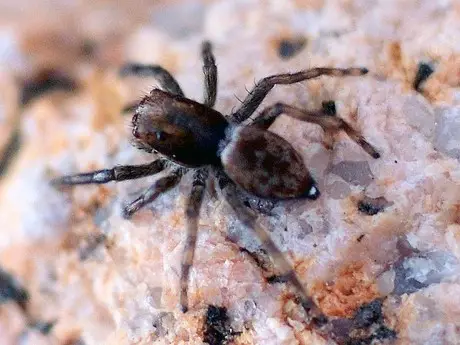
The genus Hakka contains only one species. Hakka himeshimensis is a species native in eastern Asia but has been introduced to the continental United States and Hawaii.
Hasarius
- Hasarius adansoni (Audouin, 1826) – Introduced to North America from Asia
Havaika (Hawaii)
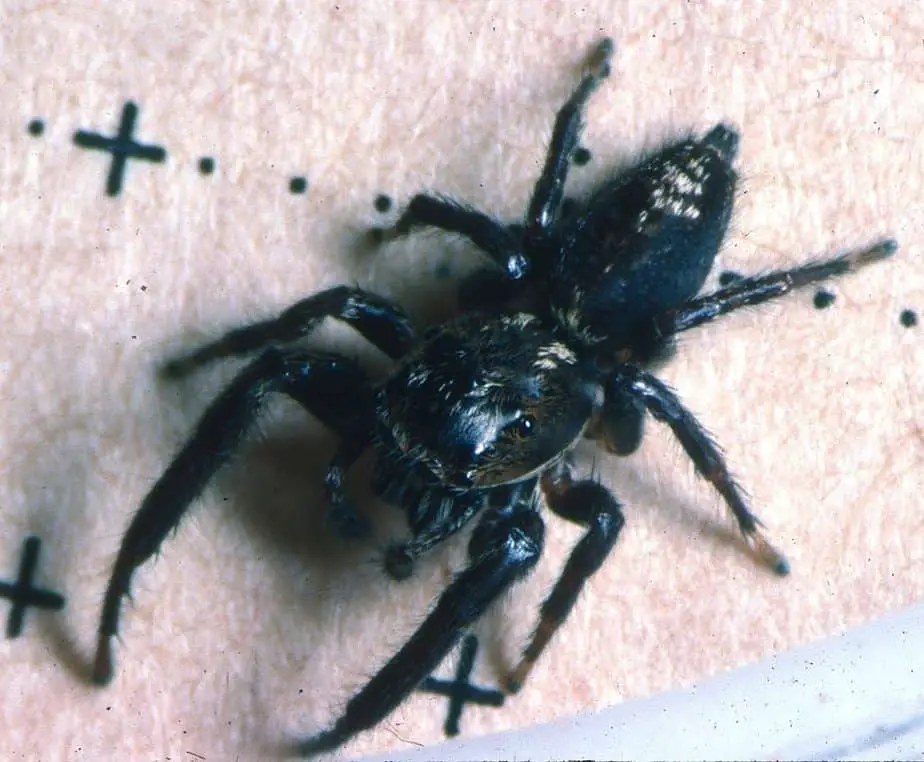
Jumping spiders of the genus Havaika occur on the Hawaiian and Marquesas Islands. They are mostly dark. Due to the drastic reduction in biodiversity on the Hawaiian Islands pver the last decades, some of the species may already be extinct. The following species are recognized:
- Havaika albociliata (Simon, 1900)
- Havaika canosa (Simon, 1900)
- Havaika cruciata (Simon, 1900)
- Havaika jamiesoni Prószyński, 2002
- Havaika pubens (Simon, 1900)
- Havaika navata (Simon, 1900)
- Havaika senicula (Simon, 1900)
- Havaika valida (Simon, 1900)
- Havaika verecunda (Simon, 1900)
- Havaika arnedoi Prószynski, 2008
- Havaika beattyi Prószynski, 2008
- Havaika berlandi Prószynski, 2008
- Havaika berryorum Prószynski, 2008
- Havaika ciliata Prószynski, 2008
- Havaika gillespieae Prószynski, 2008
- Havaika gressitti Prószynski, 2008
- Havaika kahiliensis Prószynski, 2008
- Havaika kauaiensis Prószynski, 2008
- Havaika kraussi Prószynski, 2008
- Havaika mananensis Prószynski, 2008
- Havaika mauiensis Prószynski, 2008
- Havaika oceanica Prószynski, 2008
- Havaika tantalensis Prószynski, 2008
Hentzia
Of the 22 species in the Hentzia genus, 7 occur in North America, north of Mexico. Spiders of the genus Hentzia are mostly brown colored with a long, thin abdomen and long and thick front legs.
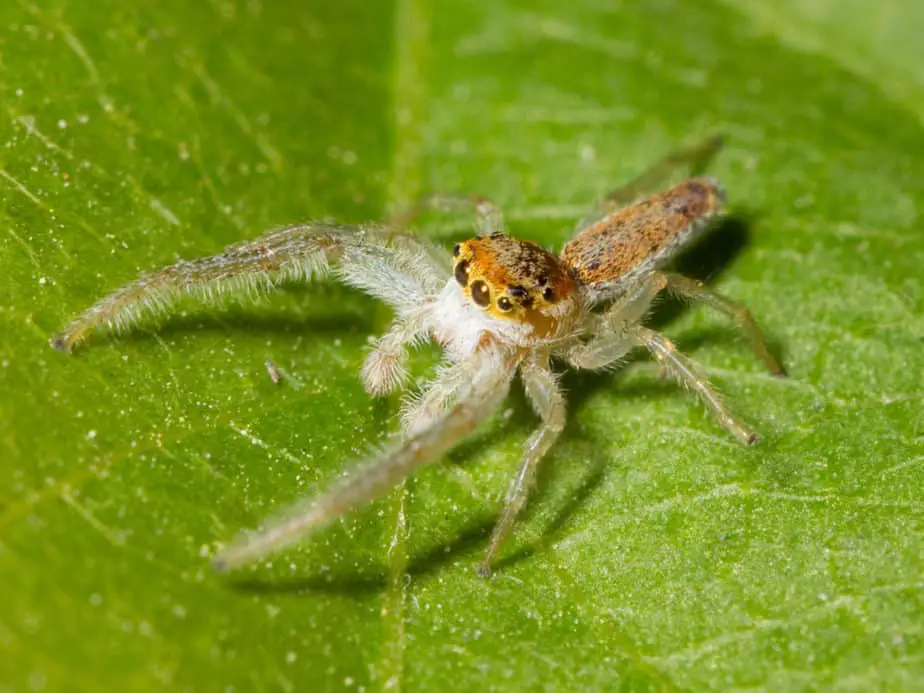
- Hentzia alamosa Richman, 2010
- Hentzia chekika Richman, 1989
- Hentzia elegans (Keyserling, 1885)
- Hentzia grenada (Peckham & Peckham, 1894)
- Hentzia mitrata (Hentz, 1846)
- Hentzia palmarum (Hentz, 1832)
- Hentzia pima Richman, 1989
Leptofreya
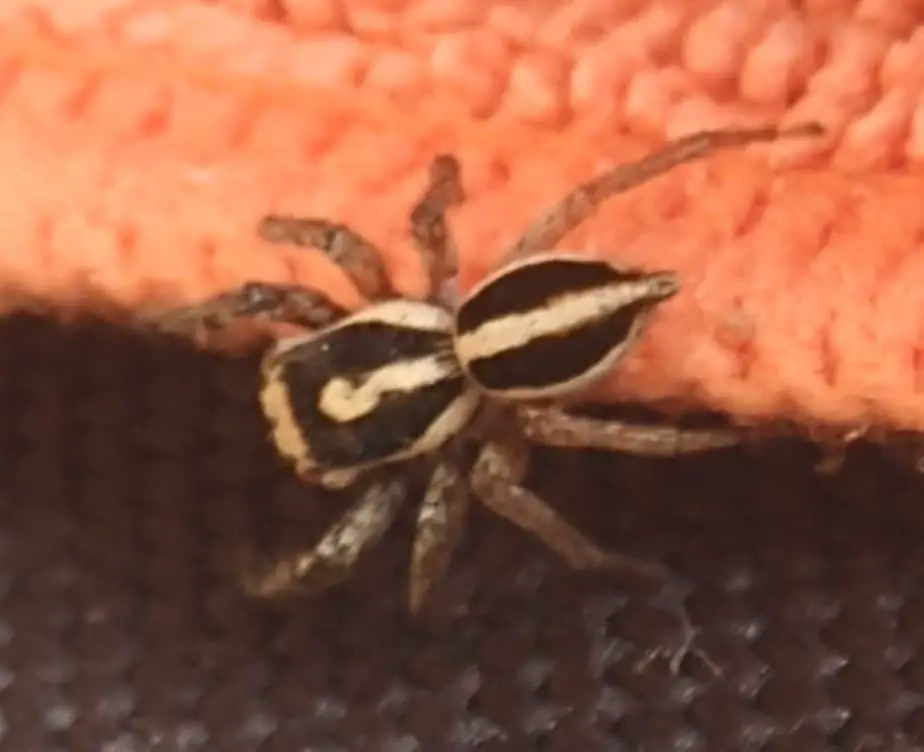
The genus Leptofreya consists of 4 species. L. ambigua has been introduced to the Southern United States from the northern Amazonas region.
- Leptofreya ambigua (C. L. Koch, 1846)
Maevia
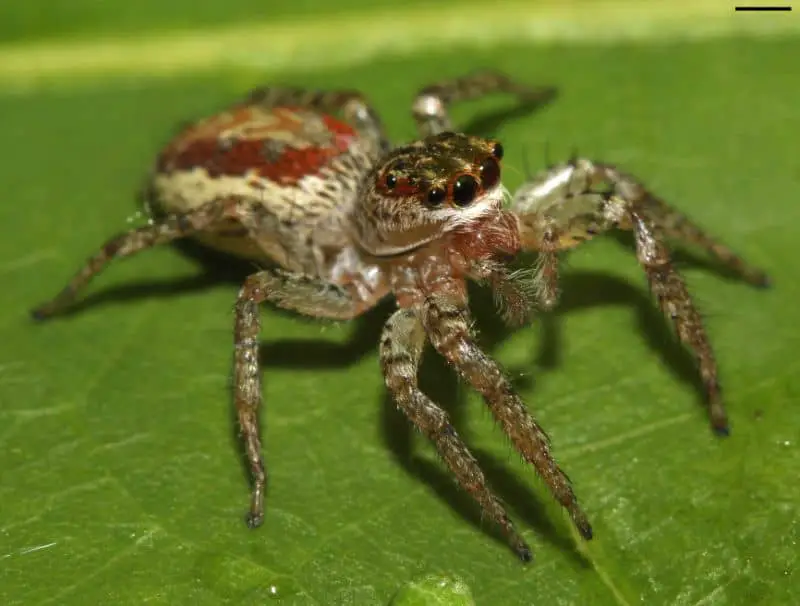
- Maevia expansa Barnes, 1955
- Maevia inclemens (Walckenaer, 1837)
- Maevia intermedia Barnes, 1955
Marchena
The genus Marchena only contains a single species: Marchena minuta. A jumping spider that can be found in the Western United States from Washington through California and Nevada.
- Marchena minuta (Peckham & Peckham, 1888)
Marpissa
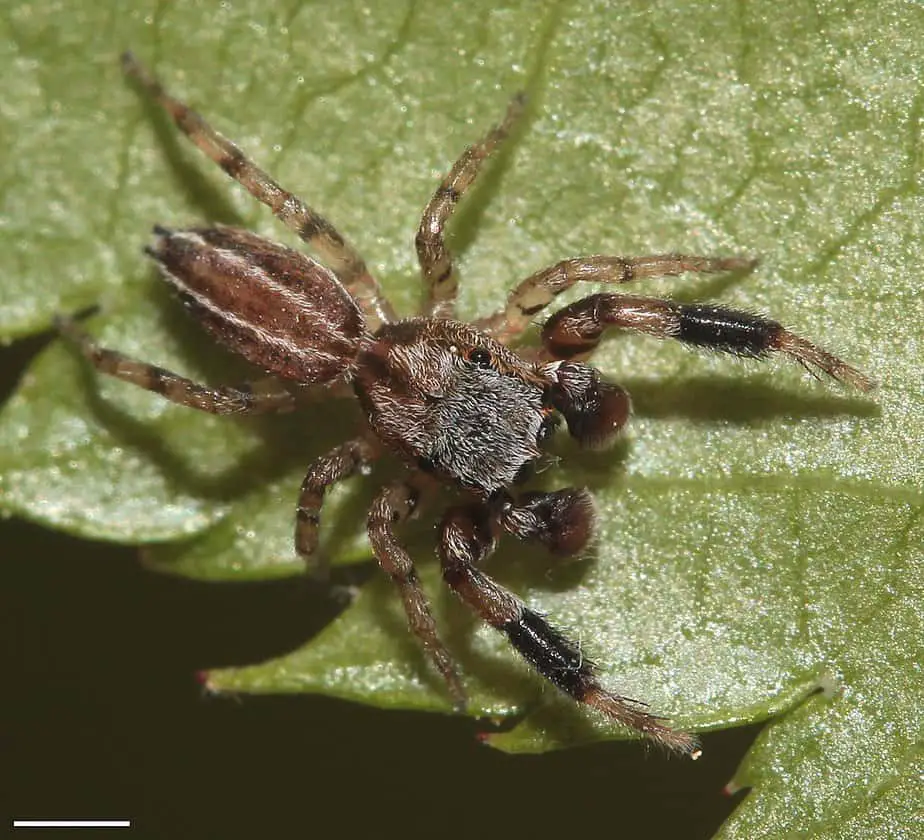
- M. lineata (C. L. Koch, 1846)
- M. grata (Gertsch, 1936)
- M. formosa (Banks, 1892)
- M. dentoides Barnes, 1958
- M. bryantae (Jones, 1945)
- M. bina (Hentz, 1846)
- M. obtusa Barnes, 1958
- M. pikei (Peckham & Peckham, 1888)
- M. robusta (Banks, 1906)
- M. sulcosa Barnes, 1958
Menemerus
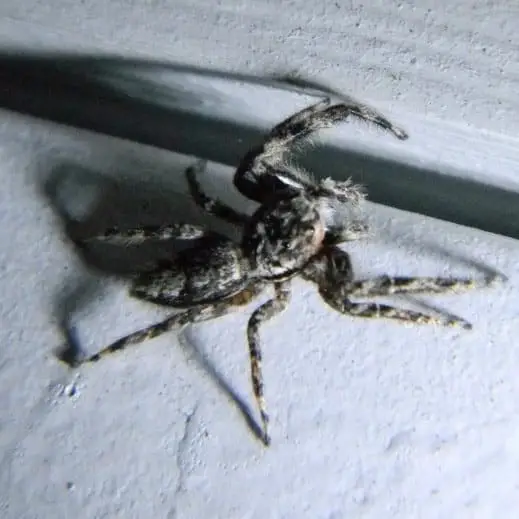
Menemerus is a genus of jumping spiders originally from the warm regions of the African and Asian continent. Two species have been introduced to North America and have established viable populations on the continent:
- M. bivittatus – Gray Wall Jumper (Dufour, 1831)
- M. semilimbatus (Hahn, 1829)
Messua
- Messua limbata (Banks, 1898)
Metacyrba
- Metacyrba floridana Gertsch, 1934
- Metacyrba punctata (Peckham & Peckham, 1894)
- Metacyrba taeniola (Hentz, 1846)
Metaphidippus
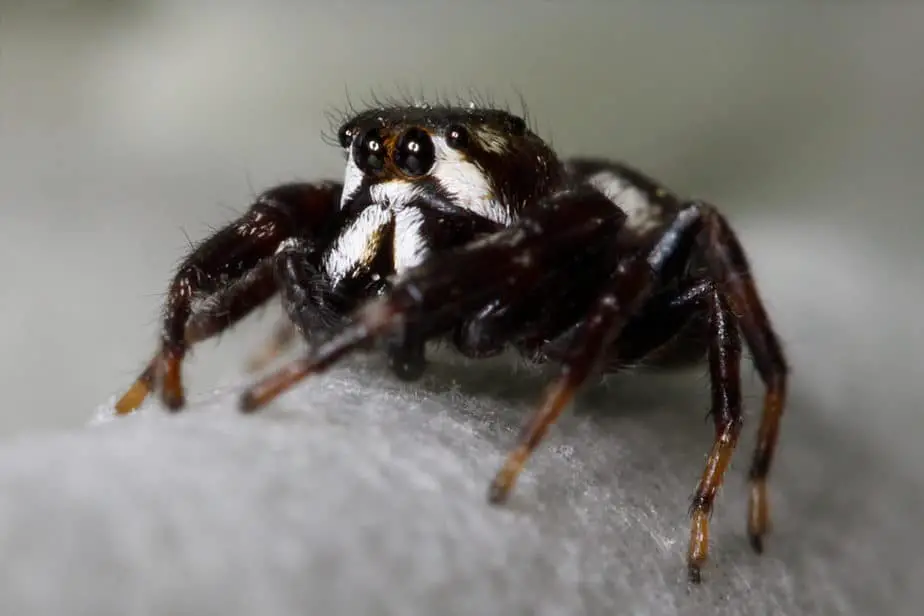
- Metaphidippus annectans (Chamberlin, 1929)
- Metaphidippus carmenensis (Chamberlin, 1924)
- Metaphidippus chera (Chamberlin, 1924)
- Metaphidippus diplacis (Chamberlin, 1924)
- Metaphidippus emmiltus Maddison, 1996
- Metaphidippus iviei (Roewer, 1951)
- Metaphidippus longipalpus F. O. Pickard-Cambridge, 1901
- Metaphidippus manni (Peckham & Peckham, 1901)
- Metaphidippus siticulosus (Peckham & Peckham, 1909)
- Metaphidippus texanus (Banks, 1904)
Mexigonus
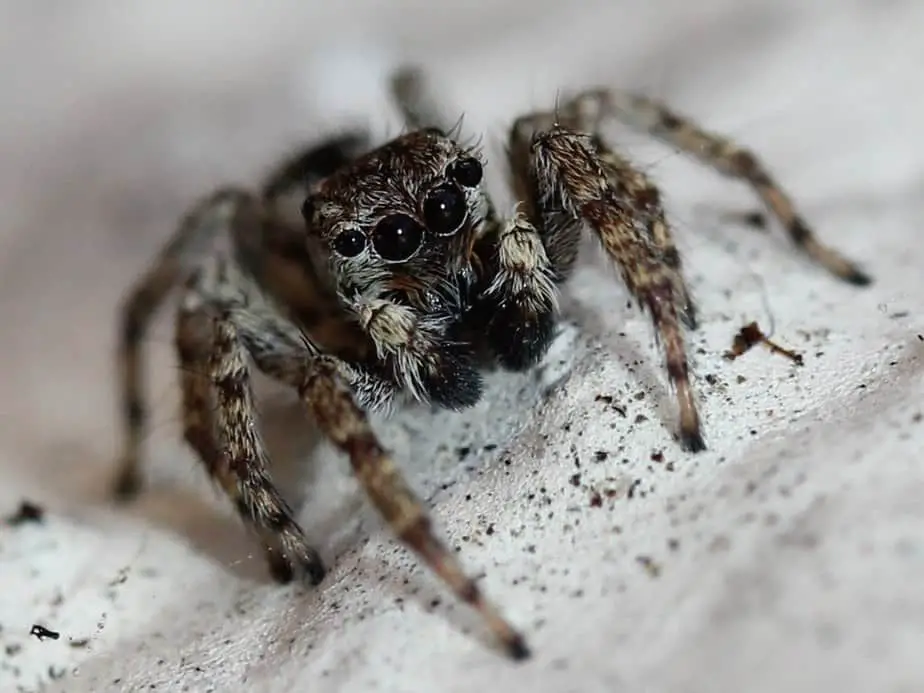
- Mexigonus arizonensis (Banks, 1904)
- Mexigonus minutus (F. O. Pickard-Cambridge, 1901)
- Mexigonus morosus (Peckham & Peckham, 1888)
Myrmarachne
- M. albocincta (C. L. Koch, 1846)
- M. formicaria (De Geer, 1778) Introduced to USA from Central Asia
Naphrys
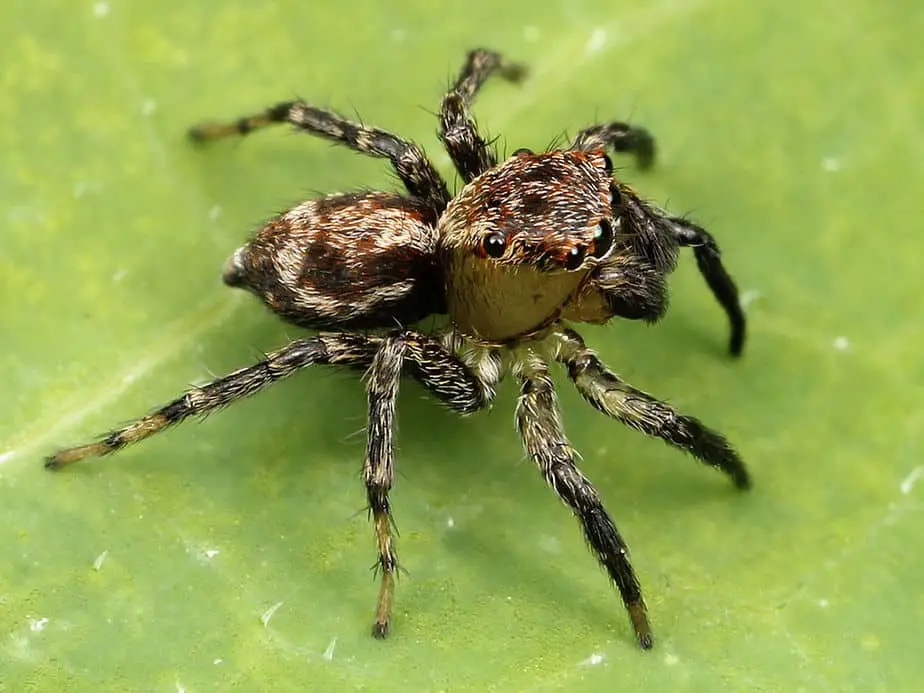
- Naphrys acerba (Peckham & Peckham, 1909)
- Naphrys bufoides (Chamberlin & Ivie, 1944)
- Naphrys pulex (Hentz, 1846)
- Naphrys xerophila (Richman, 1981)
Neon
- Neon avalonus Gertsch & Ivie, 1955
- Neon ellamae Gertsch & Ivie, 1955
- Neon nelli Peckham & Peckham, 1888
- Neon pixii Gertsch & Ivie, 1955
- Neon plutonus Gertsch & Ivie, 1955
- Neon reticulatus (Blackwall, 1853)
Neonella
- Neonella camillae Edwards, 2003
- Neonella vinnula Gertsch, 1936
Paradamoetas
- Paradamoetas fontanus (Levi, 1951)
- Paradamoetas formicinus Peckham & Peckham, 1885
Peramaevia
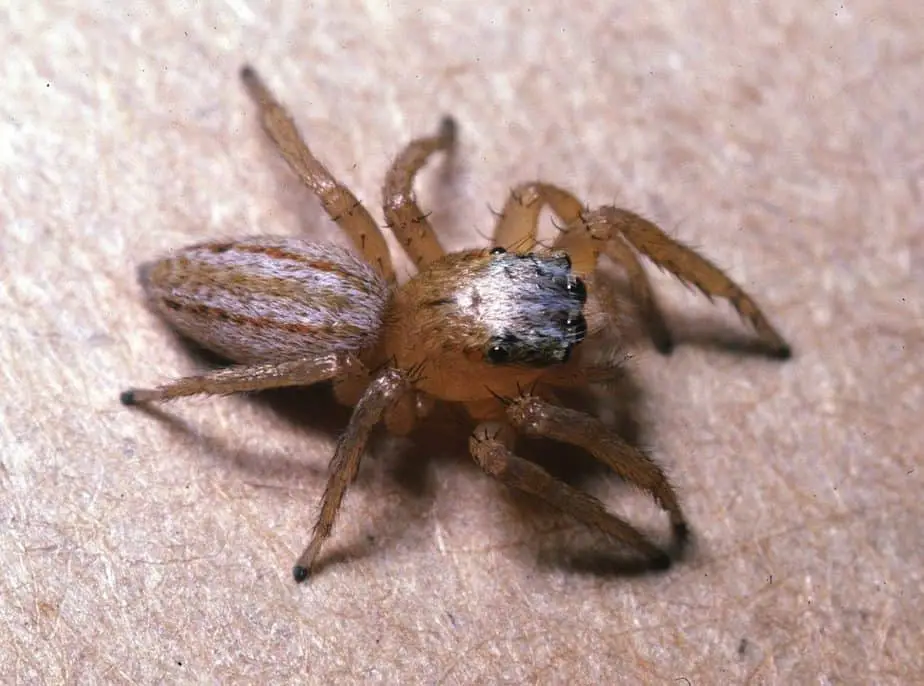
- Paramaevia hobbsae (Barnes, 1955)
- Paramaevia michelsoni Barnes, 1955
- Paramaevia poultoni Peckham & Peckham, 1901
Paramarpissa
- Paramarpissa albopilosa (Banks, 1902)
- Paramarpissa griswoldi Logunov & Cutler, 1999
- Paramarpissa piratica (Peckham & Peckham, 1888)
Paraphidippus
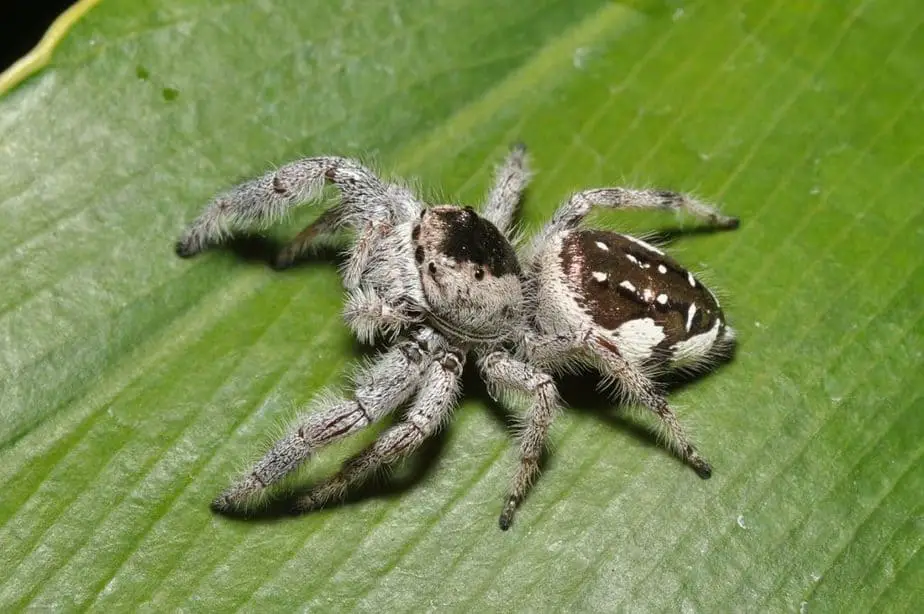
- Paraphidippus aurantius (Lucas, 1833)
- Paraphidippus basalis (Banks, 1904)
- Paraphidippus fartilis (Peckham & Peckham, 1888)
Peckhamia
- Peckhamia americana (Peckham & Peckham, 1892)
- Peckhamia picata (Hentz, 1846)
- Peckhamia scorpionia (Hentz, 1846)
- Peckhamia seminola Gertsch, 1936
Pelegrina
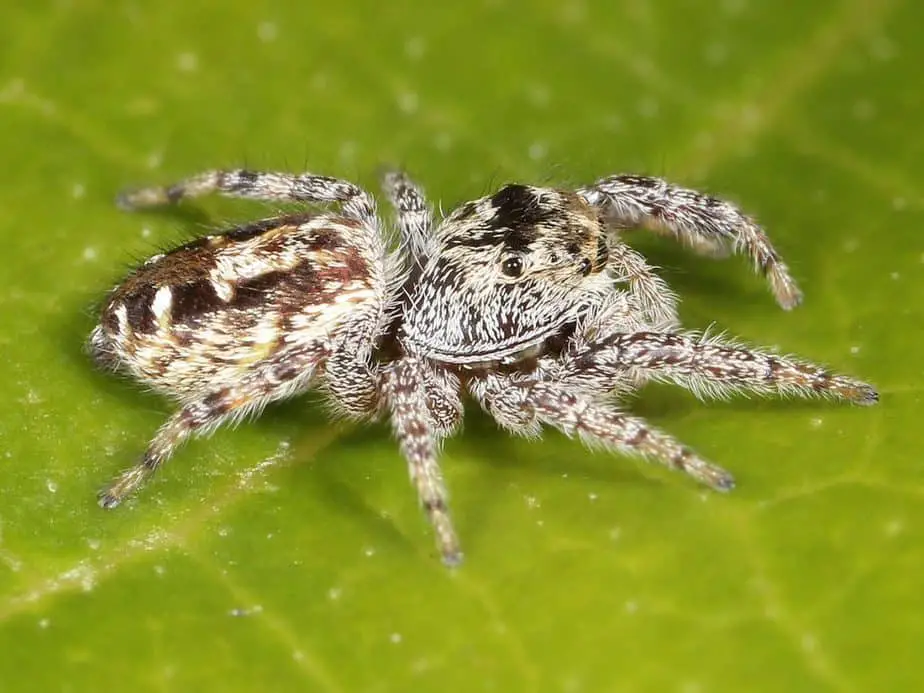
- Pelegrina aeneola (Curtis, 1892)
- Pelegrina arizonensis (Peckham & Peckham, 1901)
- Pelegrina balia Maddison, 1996
- Pelegrina bunites Maddison, 1996
- Pelegrina chaimona Maddison, 1996
- Pelegrina chalceola Maddison, 1996
- Pelegrina clemata (Levi, 1951)
- Pelegrina dithalea Maddison, 1996
- Pelegrina exigua (Banks, 1892)
- Pelegrina flaviceps (Kaston, 1973)
- Pelegrina flavipes (Peckham & Peckham, 1888)
- Pelegrina furcata (F. O. P.-Cambridge, 1901)
- Pelegrina galathea (Walckenaer, 1837)
- Pelegrina helenae (Banks, 1921)
- Pelegrina huachuca Maddison, 1996
- Pelegrina insignis (Banks, 1892)
- Pelegrina kastoni Maddison, 1996
- Pelegrina montana (Emerton, 1891)
- Pelegrina orestes Maddison, 1996
- Pelegrina peckhamorum (Kaston, 1973)
- Pelegrina pervaga (Peckham & Peckham, 1909)
- Pelegrina proterva (Walckenaer, 1837)
- Pelegrina sabinema Maddison, 1996
- Pelegrina tillandsiae (Kaston, 1973)
- Pelegrina tristis Maddison, 1996
- Pelegrina verecunda (Chamberlin & Gertsch, 1930)
Pellenes
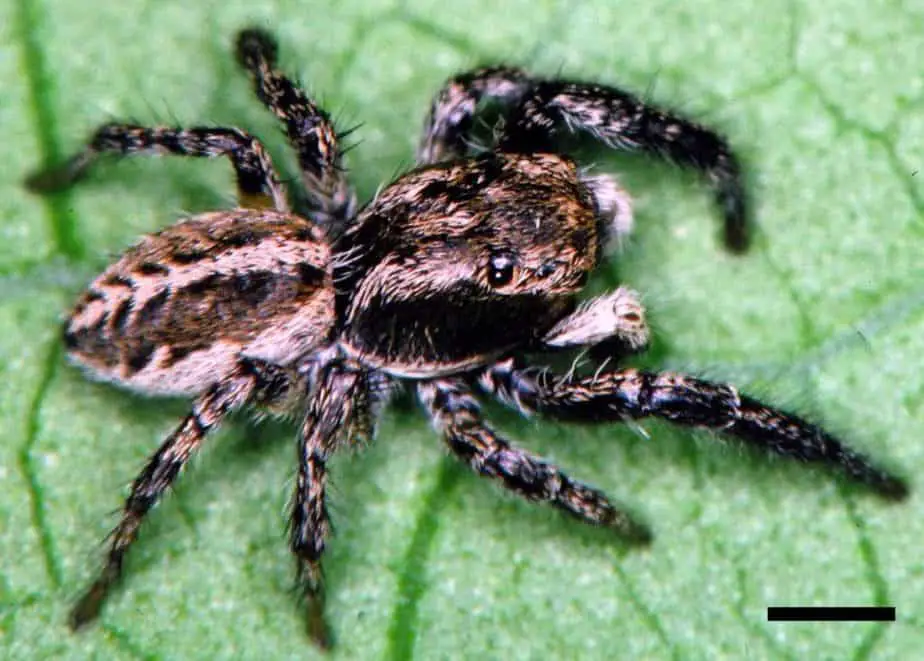
- P. apacheus Lowrie & Gertsch, 1955
- P. canadensis Maddison, 2017
- P. crandalli Lowrie & Gertsch, 1955
- P. grammaticus Chamberlin, 1925
- P. ignifrons (Grube, 1861)
- P. lapponicus (Sundevall, 1833)
- P. levii Lowrie & Gertsch, 1955
- P. limatus Peckham & Peckham, 1901
- P. longimanus Emerton, 1913
- P. peninsularis Emerton, 1925
- P. shoshonensis Gertsch, 1934
- P. washonus Lowrie & Gertsch, 1955
Phanias
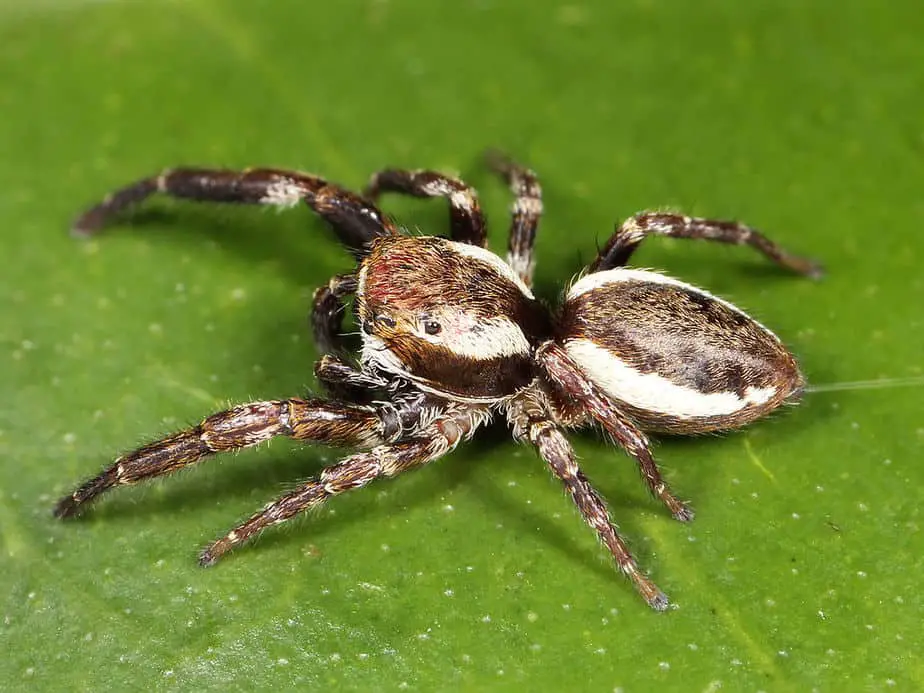
- Phanias albeolus (Chamberlin & Ivie, 1941)
- Phanias concoloratus (Chamberlin & Gertsch, 1930)
- Phanias dominatus (Chamberlin & Ivie, 1941)
- Phanias furcifer (Gertsch, 1936)
- Phanias harfordi (Peckham & Peckham, 1888)
- Phanias monticola (Banks, 1895)
- Phanias neomexicanus (Banks, 1901)
- Phanias watonus (Chamberlin & Ivie, 1941)
Phidippus
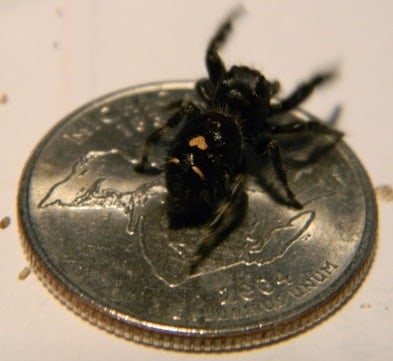
- Phidippus adumbratus Gertsch, 1934
- Phidippus apacheanus Chamberlin & Gertsch, 1929
- Phidippus ardens Peckham & Peckham, 1901
- Phidippus arizonensis (Peckham & Peckham, 1883)
- Phidippus asotus Chamberlin & Ivie, 1933
- Phidippus audax (Hentz, 1845)
- Phidippus aureus Edwards, 2004
- Phidippus bidentatus F. O. P.-Cambridge, 1901
- Phidippus boei Edwards, 2004
- Phidippus borealis Banks, 1895
- Phidippus californicus Peckham & Peckham, 1901
- Phidippus cardinalis (Hentz, 1845)
- Phidippus carneus Peckham & Peckham, 1896
- Phidippus carolinensis Peckham & Peckham, 1909
- Phidippus clarus Keyserling, 1885
- Phidippus comatus Peckham & Peckham, 1901
- Phidippus concinnus Gertsch, 1934
- Phidippus cryptus Edwards, 2004
- Phidippus felinus Edwards, 2004
- Phidippus insignarius C. L. Koch, 1846
- Phidippus johnsoni (Peckham & Peckham, 1883)
- Phidippus kastoni Edwards, 2004
- Phidippus lynceus Edwards, 2004
- Phidippus morpheus Edwards, 2004
- Phidippus mystaceus (Hentz, 1846)
- Phidippus nikites Chamberlin & Ivie, 1935
- Phidippus octopunctatus (Peckham & Peckham, 1883)
- Phidippus olympus Edwards, 2004
- Phidippus otiosus (Hentz, 1846)
- Phidippus phoenix Edwards, 2004
- Phidippus pius Scheffer, 1905
- Phidippus princeps (Peckham & Peckham, 1883)
- Phidippus pruinosus Peckham & Peckham, 1909
- Phidippus pulcherrimus Keyserling, 1885
- Phidippus purpuratus Keyserling, 1885
- Phidippus putnami (Peckham & Peckham, 1883)
- Phidippus regius C. L. Koch, 1846
- Phidippus richmani Edwards, 2004
- Phidippus texanus Banks, 1906
- Phidippus tigris Edwards, 2004
- Phidippus toro Edwards, 1978
- Phidippus tux Pinter, 1970
- Phidippus tyrannus Edwards, 2004
- Phidippus tyrrelli Peckham & Peckham, 1901
- Phidippus ursulus Edwards, 2004
- Phidippus vexans Edwards, 2004
- Phidippus whitmani Peckham & Peckham, 1909
- Phidippus workmani Peckham & Peckham, 1901
Phintelloides
- Phintelloides versicolor (C. L. Koch, 1846)
Phlegra
- P. hentzi (Marx, 1890)
Platycryptus
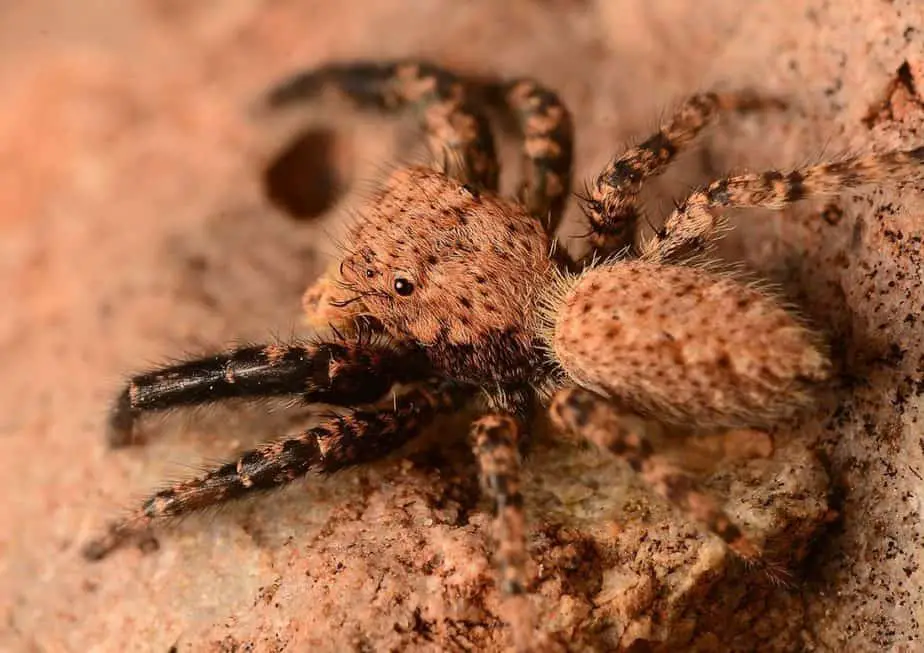
- Platycryptus arizonensis (Barnes, 1958)
- Platycryptus californicus (Peckham & Peckham, 1888)
- Platycryptus undatus (De Geer, 1778)
Plexippus
Plexippus paykulli (Audouin, 1826) – Introduced to the Americas from Africa
Poultonella
- P. alboimmaculata
- P. nuecesensis
Pseudeuophrys
- Pseudeuophrys erratica (Walckenaer, 1826) Introduced to the USA from Asia
- Pseudeuophrys lanigera (Simon, 1871)
Rhetenor
Salticus
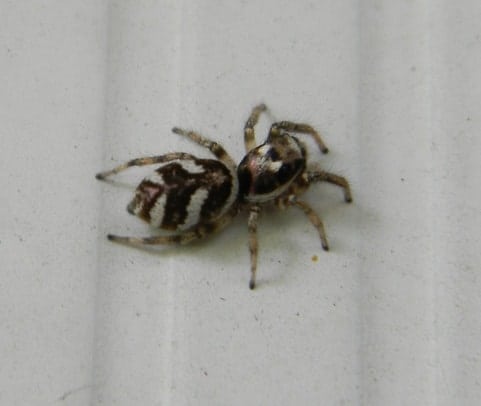
- Salticus austinensis Gertsch, 1936
- Salticus falcarius (Hentz, 1846)
- Salticus palpalis (Banks, 1904)
- Salticus peckhamae (Cockerell, 1897)
- Salticus scenicus (Clerck, 1757)
Sassacus
- Sassacus cyaneus (Hentz, 1846)
- Sassacus paiutus (Gertsch, 1934)
- Sassacus papenhoei Peckham & Peckham, 1895
Sibianor
- Sibianor aemulus (Gertsch, 1934)
Synageles
Synageles is a genus of jumping spiders mimicking the appearance of ants.
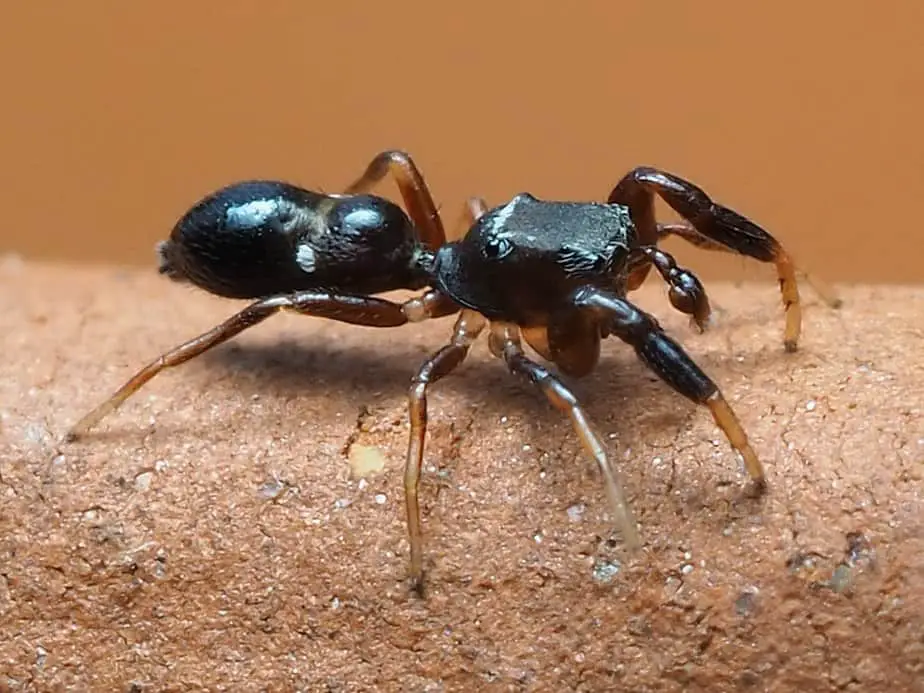
- Synageles bishopi Cutler, 1988
- Synageles canadensis Cutler, 1988
- Synageles idahoanus (Gertsch, 1934)
- Synageles mexicanus Cutler, 1988
- Synageles leechi Cutler, 1988
- Synageles noxiosus (Hentz, 1850)
- Synageles occidentalis Cutler, 1988
- Synageles venator (Lucas, 1836)
Talavera
- Talavera minuta (Banks, 1895)
Terralonus
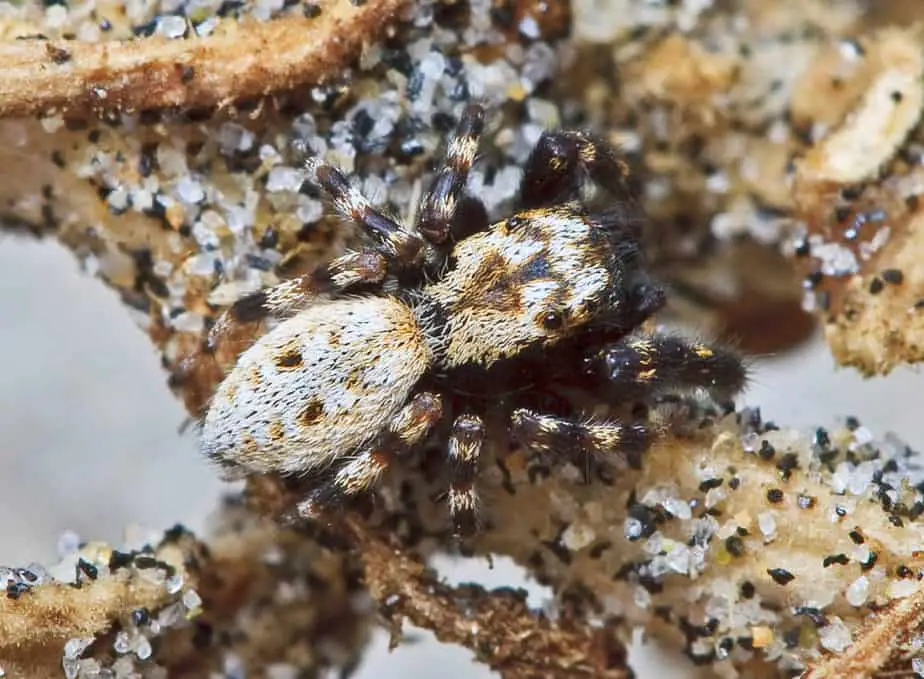
- Terralonus banksi (Roewer, 1951)
- Terralonus californicus (Peckham & Peckham, 1888)
- Terralonus fraternus (Banks, 1932)
- Terralonus mylothrus (Chamberlin, 1925)
- Terralonus shaferi (Gertsch & Riechert, 1976)
- Terralonus unicus (Chamberlin & Gertsch, 1930)
- Terralonus versicolor (Peckham & Peckham, 1909)
Thiania (Hawaii)
- Thiania suboppressa Strand, 1907 – Introduced to Hawaii from Asia
Tutelina
- Tutelina elegans (Hentz, 1846)
- Tutelina formicaria (Emerton, 1891)
- Tutelina harti (Emerton, 1891)
- Tutelina similis (Banks, 1895)
Zygoballus
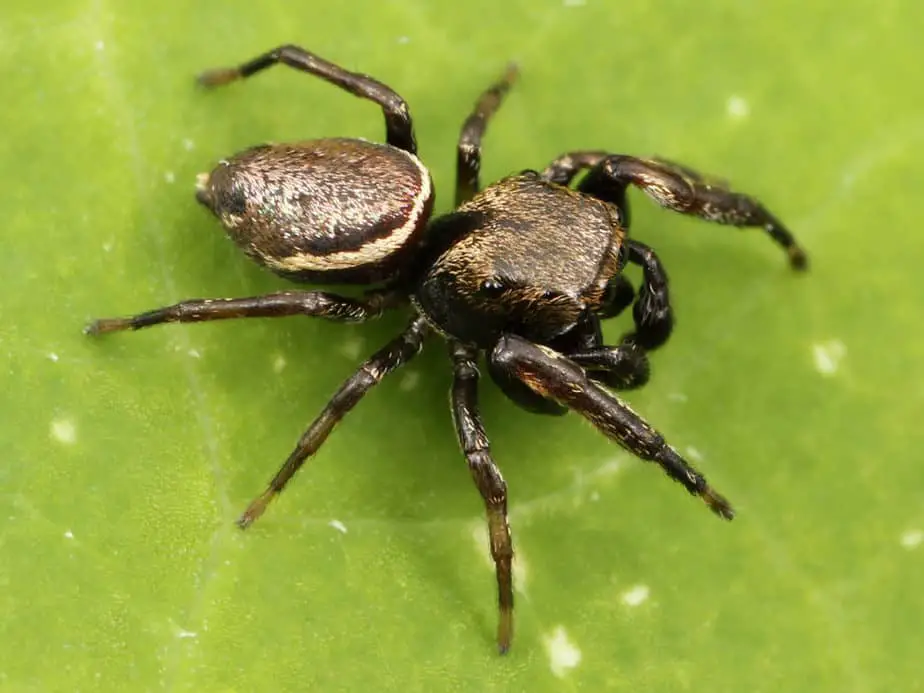
- Zygoballus iridescens Banks, 1895
- Zygoballus nervosus (Peckham & Peckham, 1888)
- Zygoballus rufipes Peckham & Peckham, 1885
- Zygoballus sexpunctatus (Hentz, 1845)

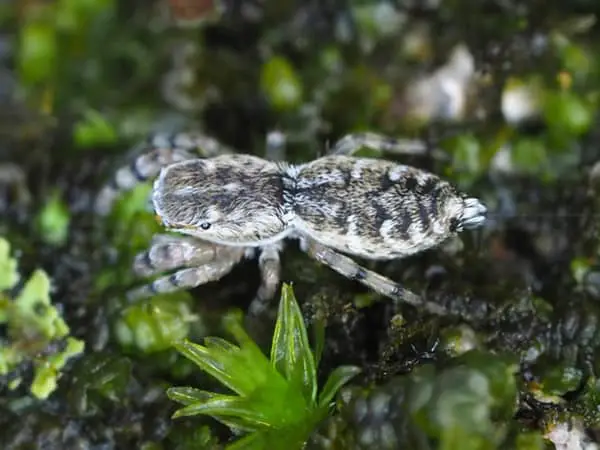
Not sure what kind of spider this is but I’ve never seen one like it ?
Hello Destiny,
This is a new one for us. It took quite some digging, but it is most certainly a female Marpissa sp. jumping spider. Probably Marpissa formosa:
https://en.wikipedia.org/wiki/Marpissa_formosa
https://bugguide.net/node/view/300423
Do you think it was this spider?
Hi! I caught this specimen in Oklahoma City Ok.
Hi there,
Thanks for reaching out.
This looks some type of jumping spider: https://usaspiders.com/jumping-spiders-of-america-north-of-mexico/
Possibly Bagheera prosper:
https://www.flickr.com/photos/thewildcarrot/41001226315/
Some sort of jumping spider, never seen one that looks like this. I’m in Gresham Oregon, Little guy was hanging out next to my trash can inside my house.
Hello Ashley,
Yes, this is a jumping spider. Most likely, Colonus sp. There are three species of Colonus jumping spiders in North America: https://usaspiders.com/jumping-spiders-of-america-north-of-mexico/#Clade_Amycoida
i am wondering what kind of jumping spider this is? i am in washington, and it doesnt seem to match the species in my state
Hello Ariel, this is a tough one 🙂 I’ve also asked some other experts and due to the photo quality, it’s not possible to give a definitive ID. Given the pattern and the location, it is most likely a California flattened jumping spider (Platycryptus californicus) – which also occurs in Washington:
https://www.inaturalist.org/observations?place_id=46&taxon_id=228315
Best regards
Michael
What kind of spider is this?
Found on the siding of our house.
Happy that it had gotten the ant as the ants here are a HUGE problem. It is welcome to stay – outside, killing ants.
Please identify this spider. We live near the Delta in Northern California. Size, approximately half inch body
Hello Cindy, thanks for getting in touch! This is definitely some type of jumping spider. Unfortunately, I won’t be able to make an exact identification since the picture is a bit blurry. There are over 350 species of jumping spiders in the U.S. alone. Jumping spiders are not considered medically significant: https://usaspiders.com/jumping-spiders-of-america-north-of-mexico/
I caught a tiny jumping spider. This is the best picture I could get of it. It really is small. My best measurement with a caliper is 4mm.
I want to know what kind or jumping spider it is, possibly what gender it is. Is it still too early to figure that out?
LoL OP here. Forgot to mention it was found in San Diego, CA.
This spider was found in south-western Ohio. Could not tell what type of web it had, but it’s silk was very thick.
Hello Kaleb, thanks for your comment. This is some type of harmless orb weaver spider in the genus Neoscona. Their colors can be quite variable and I can’t tell if this is Neoscona arabesca or Neoscona crucifera. I am leaning towards Neoscona crucifera.
Hello Sean, sorry it took me a while to get back to you. I had to ask a jumping spider expert for advice. This is a male Sassacus vitis jumper: https://bugguide.net/node/view/42637
In Helena, AL
This spider was hanging from my arm climbing up a web strand to me when I noticed it. I swiped the strand off my arm and the spider landed on the street. I was photographing butterflies at the time, so I turned my camera to this little guy and got this photo. It was small, maybe 1/2 inch across, hairy, and a very expressive face with a spikes above the eyes. I think it might be a Putnam’s Jumping Spider, but would like to be sure. Thanks.
Please help id! Found in Spokane, WA in basement. Sorry nothing in image for scale but I’d say it was almost the size of a quarter, legs included.
Hello Colleen, thanks for getting in touch! This is a folding-door spider of the genus Antrodiaetus. Here is a similar-looking fellow on Bugguide: https://bugguide.net/node/view/153294/bgimage
It’s not a medically significant spider.
Hello Woody, thanks for sharing this great shot! The black upwards pointing hairs suggest that this is a Phidippus sp. jumping spider. My best guess is Phidippus regius, but a number of spiders in the Phidippus genus can have a very variable appearance.
That face looks exactly like a Phidippus Otiosus. Wish you had an abdomen picture.
My in law was in his garage, found this weird spider on his pants & took photo today. Fargo ND. He said it jumped, was small & hairy.
Hello Brenda, this is a jumping spider (family Salticidae). I think it might be a Phidippus sp. jumping spider – but I can’t tell the exact species.
That’s almost certainly a Juvenile Phidippus Audax.
I found this little friend in TX. I was sitting on my swing when she hopped up on my leg and was munching on what I think was a mosquito. She kept acting like she was going to attack other flies and mosquitos that were landing on my leg but they flew off to fast. 🙁 I was thinking MAYBE it was a grey wall jumper, but I am uncertain.
Hello Susie, thanks for getting in touch! Tan jumpers usually have an orange band below the eyes. I think this might be some type of Phidippus sp. jumper. The long black hairs pointing upwards from the head also suggest that.
Possibly Phidippus mystaceus: https://bugguide.net/node/view/85337
Thank you! This is the best site!
Sorry to disagree but Phidippus Mystaceus are my absolute favorite and most researched jumping spider. This is not a Mystaceus, I am completely certain of that. The gray wall jumper (menemerus bivittatus) looks similar as far as abdomen goes to your picture but they usually have orange faces. However, the tan jumping spider has a bigger white band going across it’s face like your picture.
https://bugguide.net/node/view/919497/bgimage
I am not 100% sure the spider you have here is a tan jumping spider at all and I do not believe it is a grey wall jumper even though that’s what I was thinking at first. There are lighter variations in color and I have seen tan jumpers with both white and orange faces. I have also seen pictures of gray jumping spiders with white below the eyes and a darker orange or light brown above the eyes on the top half of the face. Searching now I am seeing way more tan jumping spiders faces that resemble what you have here and some so light “tan” they almost look gray or white. Hopefully you can figure it out! Adorable spiders besides 🙂
What do you make of this little guy, it seemed to be hunting flies from the flower bed. No web, it just pounces on them
Hello John, thanks for getting in touch! This is some type of jumping spider in the genus Phidippus. I can’t tell with certainty what species.
This tiny thing (smaller than the head of a pencil eraser) came out from under my keyboard just now as I was working. It kept the front 2 legs in the air for so long I thought it was some kind of insect.
Hello Randi, thanks for getting in touch! This is some type of jumping spider in the family Salticidae. Due to the number of similar-looking spiders in this family, I can’t really identify the exact species. Here is an overview of the North American jumping spiders: https://usaspiders.com/jumping-spiders-of-america-north-of-mexico/
This is a photo taken by a friend.
Fog has gathered on the web.
My personal educated guess, based on the reddish native grass supporting its web, would be a body length between .75 and 2.0 inches.
This spider is green and very small, i looked it up in Google lens it’s name is Lyssomanes viridis also known as the magnolia green jumper, please help me know how common is to find it. My name is Ricardo Espinoza and any credit please name my son Rodrigo Daniel Espinoza Agelvis. This spider spent about a hour on My arm “looking” straight at me, My son las trainning soccer so he came often to see it and tell the spider how he was doing and how beatifull the spider was. We are from Mérida a city in Venezuela , i also have a video
Hello Ricardo, thanks for getting in touch! This is a magnolia green jumper, Lyssomanes viridis: https://usaspiders.com/lyssomanes-viridis-magnolia-green-jumper/
Hello Andrew, sorry about the delay in getting back to you. This is definitely a jumping spider, possibly in the genus Phidippus. An identification on species level is not possible.
Hello! I’m in central California and found this wee fellow hanging from my jasmine arch after a good watering. There was also a tiny white sling hanging near. Such a cutie.
I found this little guy in a sandy beach of the Potomac River in King George County, Virginia. It jumped short distances, so I’m thinking it might be some sort of jumping spider, but the images don’t seem to be a good match.
Hi Chris, this is definitely a jumping spider – beyond that, I am unable to identify it.
Small spider in Albuquerque NM, please advise.
Hi Brandon, this is definitely a harmless jumping spider. I can’t say with certainty what species it is, due to the low image resolution. Compare images of male Plexippus paykulli, the pantropical jumping spider on Google – my closest guess.
Thanks for the reply. But Why is it called the “jumping” spider?
Jumping spiders (family Salticidae) have the ability to jump distances over 50 times their own body size. They do this by suddenly increasing the pressure on their behind legs, which propels them forward. These spiders are not dangerous for humans.
What kind of jumping spider is this?
If you are located in the Eastern US, this is most likely Phidippus putnami: https://bugguide.net/node/view/436677/bgpage
Help me identify this species. I believe it is in the Menemerus genus but don’t see a match for the species. Found in Mesa, Arizona in a back yard garden.
Hello,
Very nice website. I appreciate all the information. I couldn’t quite pin my spider in suspect. Could you offer any insight?
I found it at 3am – I bumped the black dot with ym fingers – it moved like an ant so I tapped it with my fingers to kill it (it knows not to be in the kitchen). When I lifted my finger the spider was stuck to it. I went to more light and grabbed my camera to get a macro lense shot. This is what I saw. My concern is a red welt on my leg, and feeling very weak and ill since then. Both mark and spider same night.
Hi Jason, this is definitely some type of jumping spider – but I can’t say what species. Given its size, I highly doubt that it would be able to bite through human skin. If it did, it could hardly lead to any effects other than some local redness.
Spiders don’t bite unprovoked – so your bite mark almost certainly comes from some type of insect or another bug.
I’m sitting at a bench near lady bird lake in Austin Texas. Suddenly this tiny spider walks up to me and has been following me since. I slide to one side of the bench, he walks back over to me. He even tried jumping onto my finger, but I shook him off. What kind of spider is it?
Hi Noah, this is a jumping spider of the genus Phidippus. I can’t determine the exact species.
Seen in Matthaei Botanical Garden in Ann Arbor, Michigan on 20220918. Maybe a Jumping Spider of some kind?
Hi and thanks for sharing this great shot! Yes, this is a jumping spider of the genus Phidippus. I can’t ID the exact species off the image, though.
Will you help me identify this jumping spider my mom found in her home in southeastern Virginia? We’re learning about spiders together 🙂
This was in my back yard in Berkeley, California. It was tiny, maybe 3-4mm long. Chalcoscirtus looks similar, but I’m not convinced this is correct, partly since iNaturalist doesn’t list this genus in this area. Any opinions would help, thanks!
Found this mystery spider on my cilantro plant in northern Illinois. Seems to be a jumping spider, but I can’t identify it.